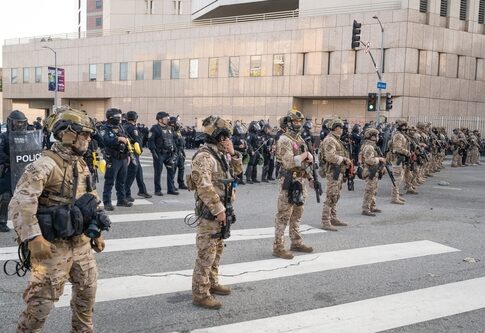Mass deportations and sweeping new powers under President Trump’s Project 2025 are rapidly transforming America’s immigration landscape, alarming defenders of constitutional rights and family unity.
Project 2025 Sets Aggressive New Immigration Enforcement Agenda
President Trump’s second term launched with the immediate rollout of Project 2025—a policy blueprint crafted by conservative groups to overhaul federal immigration enforcement. The plan empowers federal agencies to accelerate deportations, shut down the southern border, and deploy military assets to halt illegal crossings. Project 2025 calls for the use of “expedited removal” procedures nationwide, enabling Immigration and Customs Enforcement (ICE) to detain and deport individuals far from the border, including in sensitive locations like schools, hospitals, and religious institutions. These measures are designed to dismantle the patchwork of lenient policies from previous administrations, prioritizing national security and sovereignty.
Here is the Project 2025 Summary everyone needs to see.
If this does not terrify you, you have not been paying attention.https://t.co/juIWsihPX3 pic.twitter.com/2OBZ9miDYQ
— ⚓️ 🇺🇸 Proud Navy Veteran (@naretevduorp) January 8, 2024
Project 2025’s enforcement provisions eliminate long-standing protections for vulnerable populations. The plan seeks to repeal all Temporary Protected Status (TPS) designations, stripping hundreds of thousands of immigrants of work authorization and subjecting them to deportation. Protections for “Dreamers”—those brought to the U.S. as children—are targeted for removal, and categories of temporary and permanent visas are slated for reduction or elimination. The administration is also expanding detention facilities to hold up to 100,000 immigrants on any given day, regardless of whether they pose a flight or public safety risk. This approach aims to deter illegal immigration but has raised alarms about due process and humanitarian consequences.
Executive Orders and New Laws Empower Federal Agencies
Within days of taking office in 2025, President Trump signed a series of executive orders declaring a national emergency at the southern border, blocking asylum seekers, and ending catch-and-release policies. The Laken Riley Act, signed on January 29, 2025, mandates detention for immigrants charged with or convicted of certain crimes. The Department of Homeland Security reports a sharp decline in illegal border crossings and claims over 200,000 deportations in just six months. ICE, under the direction of the new “border czar,” Tom Homan, now conducts raids in cities nationwide—including in locations previously considered off-limits—disrupting families and sparking fear among immigrant communities.
THE PURGE
Polls show that Project 2025 didn’t resonate, that voters thought it wasn’t real. Well, now we’re living it and it’s already 47% complete after only 9 months.
Trump’s shutdown is a shortcut: gut the federal workforce, fire career experts, and replace them with… pic.twitter.com/JPDGOa9wpd
— Christopher Webb (@cwebbonline) October 3, 2025
This surge in enforcement extends to the home front. In March 2025, the Attorney General authorized law enforcement to enter migrant homes without warrants, a move that has sparked legal battles and drawn criticism from rights advocates. President Trump has called for retaliation against attorneys deemed to be obstructing deportations, intensifying the climate of tension and uncertainty. These actions test the boundaries of executive power and are being closely scrutinized by legal experts and advocacy groups.
Legal and Constitutional Concerns Fuel Debate
Critics argue that Project 2025 and related executive actions erode due process and constitutional protections. The expansion of expedited removal procedures and the elimination of “sensitive locations” policies allow ICE to operate with fewer checks on its authority, raising questions about the balance between national security and civil liberties. Legal challenges are mounting, with courts asked to weigh the administration’s sweeping powers against longstanding constitutional guarantees. The debate underscores a deep divide: while many conservatives view these measures as necessary to restore order and uphold American sovereignty, others warn of government overreach and the erosion of fundamental rights.
Amid this upheaval, Americans are left to grapple with the consequences for families, communities, and the nation’s core values. Supporters of the administration’s approach see it as a long-overdue correction to years of lax enforcement and unchecked migration. Detractors, however, warn that the aggressive tactics risk undermining the very liberties and constitutional principles conservatives hold dear. As Project 2025 continues to reshape the immigration system, the nation faces urgent questions about how far government should go to secure the border—and at what cost to freedom and justice.
Sources:
Project 2025: What’s At Stake for Immigrants’ Rights
Immigration policy of the second Trump administration – Wikipedia
The Trump Administration’s 2025 Changes to Immigration Law …
Protecting The American People Against Invasion – The White House
The Anti-Immigrant Policies in Trump’s Final “Big Beautiful Bill …
The Trump Administration Moves to Reinstate Restrictions on Legal …
Trump on Immigration | American Civil Liberties Union

